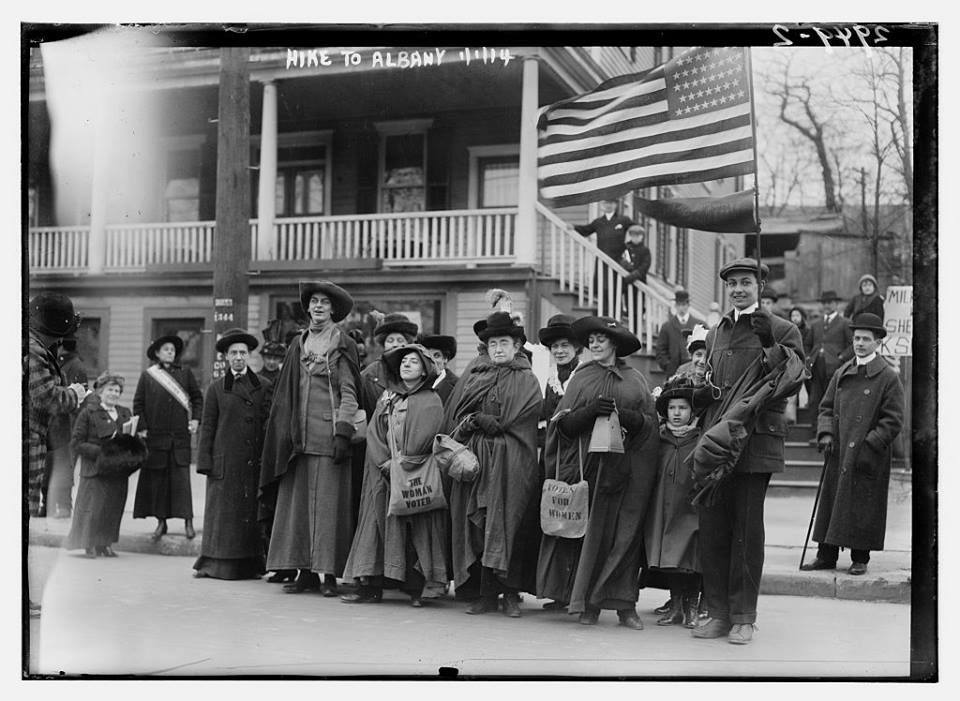
Today in Feminist History is our daily recap of the major milestones and minor advancements that shaped women’s history in the U.S.—from suffrage to Shirley Chisholm and beyond. These posts were written by, and are presented in homage to, our late staff historian and archivist, David Dismore.
January 7, 1914: She’s done it again! For the third time in 13 months, General Rosalie Jones has successfully led a small army of suffragists to their destination.

Her first—and totally unprecedented—”suffrage hike” left the Bronx on December 16, 1912, and arrived in Albany 12 days later. The purpose of the event was to deliver a message from prominent New York suffragists to Governor-elect William “Plain Bill” Sulzer, and then get him to formally support woman suffrage. They succeeded on both counts.
The massive and favorable publicity generated by their first adventure led to a far more ambitious trek from Newark, New Jersey, to Washington, D.C. In addition to promoting the cause, they also wanted to be a part of the landmark suffrage parade and pageant held in the nation’s capital on March 3, the day before President Wilson’s inauguration.
The third hike ended at 2:35 this afternoon, after having begun on New Year’s Day. It obviously went at a much faster pace than their first march to Albany. The goal of about 25 miles a day for six days was achieved by these experienced hikers despite roads that according to General Jones were in even worse condition this year than in 1912.
Three of the eleven who arrived today hiked the entire 166 miles: General Jones, Colonel Ida Craft and Corporal Martha Klatchken, all veterans of previous hikes. Though their goal was the same as 13 months ago—to deliver a message and gain the Governor’s endorsement of a Statewide suffrage referendum—there was a new chief executive to lobby. Sulzer was impeached and removed from office on October 17th, nine and a half months after being sworn in on January 1, 1913.
This year’s hike was beset with all the familiar problems, from muddy roads to high winds, bitter cold and snowstorms. General Jones often had to take breaks, as well as use a cane. But as always, the hikers just kept marching on, and today reached their destination. They were met at the edge of town by 200 cheering supporters, and were escorted the final few miles of their journey by the Albany Political Equality Association, plus a fife and drum corps.
After some speeches to the crowd on the street, the hikers went into the Assembly Chamber, where they individually urged their representatives to vote for a current bill that would allow women to act as poll-watchers. This is a wise precaution to assure an honest election when woman suffrage goes on the New York State ballot next year on November 2. The reception was friendly, and General Jones even got a chance for some much-needed rest in one of the chamber’s many comfortable leather chairs.
Following their meeting with the legislators, the pilgrims went to see Governor Martin G. Glynn. When she met with him, Jones was carrying a lighted lantern, and when questioned about it, she said that in the tradition of Diogenes, she was “looking for an honest statesman.” Governor Glynn assured her:
“You will find plenty of them here.”
After some initial resistance, Glynn and his secretary, Frank Tierney, accepted “Votes for Women” buttons, then praised the hikers for their zeal. But unlike his predecessor, Glynn did not make any official endorsement of the referendum, or a commitment to the cause.
Though Jones said that she didn’t want to make another hike, she also said:
“We shall march next year, however, and every year thereafter until women are granted suffrage.”
So, the struggle—and presumably the hikes, as well as the massive marches and colorful pageants by other groups—will go on!





